Summary
High-power continuous wave lasers (also known as “high-energy” lasers) are increasingly common in manufacturing (welding, cutting, and metal additive manufacturing/3D printing), materials processing and testing, and defense applications. Accurately measuring the output power of these lasers can be challenging. We have found that measuring laser power using its radiation pressure offers several unique advantages. We are implementing a variety of radiation-pressure based approaches to power and energy measurement.
Description
Traditional power meters measure the power of a laser beam by absorbing its energy. Radiation pressure (photon momentum) permits the measurement of a beam’s power by “absorbing” its momentum and reflecting its energy. Light reflecting from a mirror causes a force that is proportional to its optical power without suffering from the thermal effects of high-power lasers. This mitigates the need for thermal management, reduces measurement response time, and permits high-accuracy measurement of a laser beam’s power without interrupting its operation. We are developing radiation-pressure based power measurements to facilitate accurate measurement of the world’s highest power CW lasers, to provide calibrations for traditional power meters, and to establish power traceability to Planck’s constant and by way of the kilogram.
We welcome measurement challenges and collaboration opportunities for measuring ever higher or inaccessible laser powers.
Radiation Pressure Power Meter
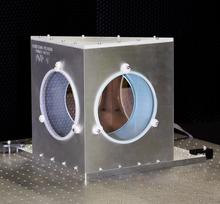
The Radiation Pressure Power Meter (RPPM) is based on a commercial force balance and has participated in multiple measurement campaigns measuring laser power with expanded uncertainties of approximately 1.6 % (k=2) or less from 1 kW to 140 kW and energies up to 100 J/pulse – no upper power or energy limit has yet been encountered. Full disclosure of this patented design is available along with possibility for custom testing.
References:
- P.A. Williams, et al., “Portable high-accuracy non-absorbing laser power measurement at kilowatt levels by mean of radiation pressure,” Opt. Exp., 25(4), 4382-4392 (2017). DOI: 10.1364/OE.25.004382
- P.A. Williams, et al, "Extreme laser pulse-energy measurements by means of photon momentum," Opt. Express 30, 7383-7393 (2022). DOI: 10.1364/OE.448815
- P. A. Williams et al., "Radiation-Pressure-Enabled Traceable Laser Sources at CW Powers up to 50 kW," in IEEE Trans. Instrum. and Meas., vol. 68, no. 6, pp. 1833-1839, June 2019. DOI: 10.1109/TIM.2018.2886108
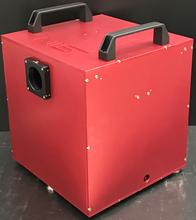
Axial Force Radiometer
The Axial Force Radiometer is a radiation pressure power measurement device designed around a commercial force balance but intended for bench-top use with collinear entrance and exit beam and sub-2 % uncertainty (k=2) from 1-20 kW (CW). Full documentation of this instrument is available as well as patent licensing opportunities.
References:
- P.A. Williams, et al., “Axial force radiometer for primary standard laser power measurements using photon momentum,” Metrologia, 58, 015010 (2021). DOI: 10.1088/1681-7575/abcd81
Smart Mirror
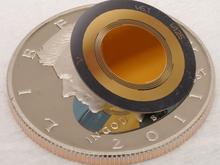
This micro-electro-mechanical (MEMs) device uses a spring-suspended mirror to measure laser power with immunity to vibration. Intended operation is as an in-situ laser power meter for operating lasers in the laboratory or on the manufacturing floor. Operation has been demonstrated with commercially available parts and is patented for further licensed development.
References:
- Smart Mirror description
- A.B. Artusio-Glimpse, et al., “Miniature force sensor for absolute laser power measurements via radiation pressure at hundreds of watts,” Opt. Exp., 28(9), 13310-13322 (2020). DOI: 10.1364/OE.385502
Low-power sensor based on magnetic levitation
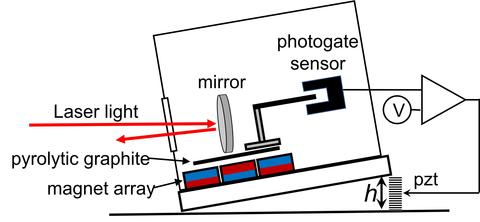
To test simplification of radiation-pressure based power measurements, we have demonstrated a gravity-enforced photon momentum radiometer using magnetically levitated graphite as a low-friction coupling and gravity as the restoring force to produce a potentially low-cost primary standard power meter with a noise equivalent power of 30 mW rms noise floor.
References:
- A. Vaskuri, "Absolute radiation pressure detector using a diamagnetically levitating test mass," Optica 8, 1380-1387 (2021). DOI: 10.1364/OPTICA.437586
High Amplification Laser-pressure Optic (HALO)
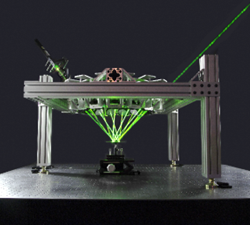
As a non-absorbing measurement technique, the optical signal of a radiation-pressure based power measurement can be multiplied merely by increasing the number of times it reflects from the same mirror. Since the noise floor is largely independent of laser power this offers the possibility of improved measurement uncertainty with an appropriately designed power meter. We are testing the limits of uncertainty afforded by such a device.
References:
- High Amplification Laser-pressure Optic
- A.B. Artusio-Glimpse, et al., “High amplification laser-pressure optic enables ultra-low uncertainty measurements of optical laser power at kilowatt levels,” Metrologia, 58(5) 055010 (2021). DOI: 10.1088/1681-7575/ac1e34

